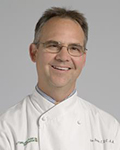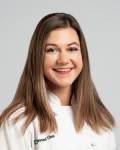Overview
Culinary Medicine at the Cleveland Clinic combines evidence-based science of food, nutrition, and medicine with the joy and art of cooking developed by our team of physicians, dietitians, and chefs.
Whether you’re trying to lose weight or are newly diagnosed, we offer Culinary Medicine education so you won’t compromise the taste of your meals or your health. The right foods, prepared correctly, can help to improve and/or reverse common chronic diseases. These include diabetes, high blood pressure (hypertension) and obesity.
- Learn more about our chefs.
- Call 216.448.4325 to schedule a private or group appointment.
Helpful tips to get you started
In Culinary Medicine, our goal is to help you reach your food and cooking goals so that you won’t compromise the taste of your meals and your health. Here are tips that can assist in mealtime and learning to love the foods that love you back!
- Choose to eat foods that promote good health.
- Don’t think about what you can’t have – Instead, think about all the things you can have.
- Know the foods you like that may also boost immunity, fight inflammation and are compatible with any dietary restriction(s) you may have. Then build your meals from those foods.
Teach to fish vs. giving a fish. Knowing the techniques, such as how to make something moist without added fats, sweet without added sugars, and savory without added sodium, can be applied to almost any dietary pattern.
Good in will help you achieve good out. Starting with fresh quality ingredients and handling them appropriately increases chances of getting healthy and delicious outcomes.
Consistent size means even cooking. Practice knife skills to create similar sized pieces for even cooking and doneness.
Increase surface size to increase area to flavor. Cutting the foods into small pieces increases the surface to volume ratio and thus boosts the area you can flavor. For example: It would be difficult to caramelize a whole onion but it’s easy to caramelize an onion that is diced.
Satisfaction and knowledge encourage positive dietary choices. Enjoying and “Loving the Foods that Love YOU Back” will help you with long-term adherence with healthy choices you are making.
Begin with mis en place – the French term meaning “to put in place.” Gather, measure, and prepare all of your ingredients and equipment prior to starting to cook.
Make mealtime eventful.
- Practice mindfulness and hospitality by creating an attractive plate presentation. Arranging foods on a plate or serving a platter makes the act of creating meal more enjoyable. It is the essence of hospitality and caring.
- Positive mealtimes, and cooking with family members, creates “food memories” that are carried for life! Take three deep breaths before beginning to eat to be more present and enjoy your food.
- Chew your food slowly and mindfully to improve digestion and satiety. Try to only eat to 80% full or just satisfied / no longer hungry.
- Whenever possible try to eat most of your foods early in the day and ideally before 6 pm.
Gain practical physical activity and efficiency. The entire process of making a meal is a source of functional exercise. The shopping, cutting, chopping, cooking and cleaning are all forms of physical activity.
The safety and importance of knife skills.
- Use the right tool for the right job. A big knife (an 8” French knife) for a big job, like cutting through a butternut squash, and a little knife for a little job, such as a paring knife for cutting strawberries. Place a damp paper towel or dish towel underneath the cutting board to prevent it from slipping.
- Always point the knife away from you.
- See the Knife Skills flyer for how to hold and cut with a chef’s knife.
Sweeten dishes without adding sugars.
- Sweeten dressing or vinaigrette with fresh fruits like berries or unsweetened dried fruits as health-promoting natural sugars to avoid adding simple sugars such as agave, honey or maple syrup. This will sweeten, add dietary fiber, antioxidants and anti-inflammatory phytonutrients – see recipe Raisin Reduction.
- Flavor and sweeten greens, like swiss chard, with vegetables like butternut squash.
- Cook onions separately, and until transparent, to release the strong sulfur flavor - especially before adding broth. Continued cooking will caramelize the naturally occurring sugars and create delicious sweetness, like in grilled onions.
Moisten foods with less “added” fat.
- Moisten grains with a variety of plant foods. Use mushrooms and vegetables like zucchini, green beans, peppers and leafy greens to moisten whole grains like farro, bulgur, whole grain brown rice, quinoa, millet, 100% whole grain pasta or 100% brown rice gluten-free pasta – see recipes for Vegetable Rice and One Pot Quinoa.
- Prepare a vinaigrette or salad dressing by using a 1:1 ratio of acid to oil instead of 3 parts oil to 1 part acid, as usually done in classic cooking – see recipes for Broccoli Bean Salad, Quinoa Tabbouleh and Edamame Salad).
- Make a salad dressing with NO added oil, sugar or sodium – see recipe for Blueberry, Fig and Balsamic Dressing.
- Use small amounts of oil when making rubs to roast potatoes, carrots and other vegetables. A little bit of oil goes a long way. Make it work for you!
Increase flavor while reducing added sodium.
- Using acids, like lemon juice, lime juice and vinegar, will create flavor profiles that reduce the desire for sodium. Consider this: wine is an acid and no one adds salt to their wine!
- Hot chilies, like jalapenos, can lessen the desire for added sodium.
- Using toasted spices and nuts in recipes creates more flavor and lessens the craving to add sodium.
Substitutions to consider for those with dietary restrictions.
- Nut allergies – use seeds like sunflower seeds and pumpkin seeds instead.
- Dairy allergies – use alternative milks such as soy, almond, hemp, oat, and cashew.
- Gluten allergies – replace 100% whole wheat pasta with 100% brown rice pasta or bean pastas like chickpea pasta. Substitute 100% whole wheat flour for gluten-free flours made from brown rice, almonds, chickpeas or buckwheat.
Follow “Cleveland Clinic Go! Foods” guidelines.
- Saturated fats: Less than 4 grams for main dishes; less than 2 grams for side dishes, soups and desserts.
- No hydrogenated or trans fats.
- Added sugars and syrups: Less than 4 grams for main dishes and desserts; less than 2 grams for side dishes and soups.
- 100% Whole Grain.
- Sodium: No more than 600 mg in entrees; 480 mg in side dishes and desserts.
Professional Associations related to Culinary Medicine
- Teaching Kitchen Collaborative
- American College of Lifestyle Medicine
What to Expect
The Culinary Medicine Consult is a one-on-one appointment with Executive Chef Jim Perko, Sr., CEC, AAC. Chef Perko is a Certified Executive Chef from the American Culinary Federation.
Culinary Medicine combines nutrition and cooking knowledge to help you achieve and maintain good health. During the initial two-hour consultation, we will work with you to create a personalized culinary medicine plan based on:
- Your food preferences.
- Your current knowledge about recipes and techniques.
- Your ability to cook and prepare meals.
- What is available in your kitchen.
- What family support you have.
- Your dietary restrictions.
Our goal is to work with you to create a food and cooking plan that won’t compromise the taste of your meals or your health. We want to leave you with knowledge about culinary medicine techniques you can easily perform, maintain and share with your family.
Insurance Coverage
Culinary Medicine is available as an out of pocket expense and is not currently covered by insurance.
$200 for two-hour, in-person consultation at the Culinary Teaching Kitchen. Fee includes personalized culinary teaching and food.
Call 216.448.4325 to schedule.
Culinary Medicine SMA
Overview
The Culinary Medicine for Chronic Disease Shared Medical Appointments (SMAs) utilize culinary medicine to improve and possibly even reverse common chronic diseases including diabetes, high blood pressure (hypertension), high blood cholesterol (dyslipidemia), and obesity. The Culinary Medicine for Chronic Disease SMA is for adults of any age who have been diagnosed with two or more lifestyle-related chronic conditions.
Each series will consist of 4 virtual sessions, 90 minutes long each. In these, you will learn how to shop, plan and prepare healthy meals, and will get samples to taste how great nutritious meals can be. There are currently two options for times:
- Mondays 5:30 p.m. to 7:00 p.m.
- Tuesdays 1:30 p.m. to 3:00 p.m.
How the Program Helps
Culinary Medicine for Chronic Disease SMA is a series of four six shared group medical appointments facilitated by a physician and professional chefs. You will learn the following skills that can help you take control of your health:
- Recognize the healing potential of different types of whole foods.
- Learn how to read labels and make healthy choices at the grocery store.
- Develop a foundation of culinary techniques to create simple, healthful meals at home.
In the appointments, you will:
- Learn the research on how food can act as medicine.
- Have the opportunity to practice your new skills with individual feedback and encouragement from our team.
- Sample the delicious recipes prepared during the appointment. You will receive a packet of recipes created by our chef to use at home.
Your individual medical concerns will be evaluated in a one-on-one appointment with a physician prior to the first session.
Appointments
To schedule an initial screening visit or to learn more about the Culinary Medicine for Chronic Disease SMA, please call 216.448.4325, option 1.
Insurance Coverage
Shared medical appointments are covered by most insurance plans. Patients are responsible for insurance co pays at the weekly appointments. There is no copay for Cleveland Clinic Employees.
For current dates and times and to register or reserve your spot, please call the Cleveland Clinic Center for Integrative and Lifestyle Medicine at 216.448.4325, and select option 1.
Our Team
|
Jim Perko Sr. |
Gabrielle Shipta |
Appointments & Locations
Culinary Medicine appointments are offered at one of our Cleveland Clinic Administrative Buildings, please call 216.448.4325 to schedule an appointment with our team.
Location
Administrative Campus Building 4
3175 Science Park Drive
Beachwood , Ohio 44122

